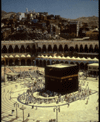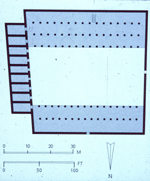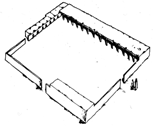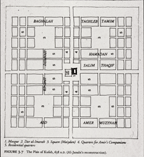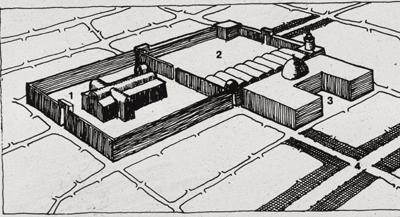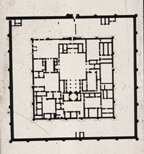AGA KHAN PROGRAM FOR ISLAMIC ARCHITECTURE
Course 4.611/4.613:
2- Early Urban Settlements: (Click on images to enlarge)
The Ka'ba in Mecca:
The axis mundi of the Muslim world conception and the qibla towards which worshippers face when praying. Date of building is unknown, but it was rebuilt during the lifetime of Muhammad and several times afterwards.
View of the Ka'ba before the most recent Saudi expansions of the haram. |
The House and Mosque of the Prophet at Medina:
=The Islamic prototype of both religious and residential architecture, built in 622 C. E. (1 A.H. or After Hegire, the immigration of the Prophet to Medina), and enlarged several times in the first century of Islam. It was rebuilt almost completely by the Al Saud ruling family in the last 20 years.
Plan of the prophets mosque in Medina |
Axonometric of the Prophet Mosque in Medina |
Misr:
Name of early Islamic garrison towns, founded in the conquered regions. The most famous amsar (pl. of misr) were Busra and Kufa in Iraq, Jabiyya in Syria, Fustat in Egypt, and Qayrawan in Tunisia. These settlements grew from informal encampments around a central mosque to capital cities within the first century Hegire (7th-8th century C. E.).
Reconstruction of the plan of the city of Kufa |
The Umayyads:
The first Islamic dynasty (661-750) established by a companion of the Prophet, Mu‘awiya. Their capital was Damascus, but they considered the whole of Bilad al-Sham (Greater Syria) their base. The first Islamic monuments were built under the Umayyads.
The Caliphal Palace at Damascus:
The Green Dome (al-Qubba al-Khadra), founded ca. 70 by Mu'awiya, was a very simple structure that was ridiculed by a Byzantine envoy.
Caliphal Palace of Damascus A reconstruction of the relationship between the Green Dome Palace (3), the Early Mosque of Damascus (2), and the Church of St. John the Baptist (1) by Nezar AlSayyad.
|
The Governor Palace (Dar al-Imara) of Kufa, Iraq:
At its second excavated level (ca. 670) displays much more sophisticated stone structure with a series of courtyards than the first level.
Plan of the second level of Dar al-Imara in Kufa |
